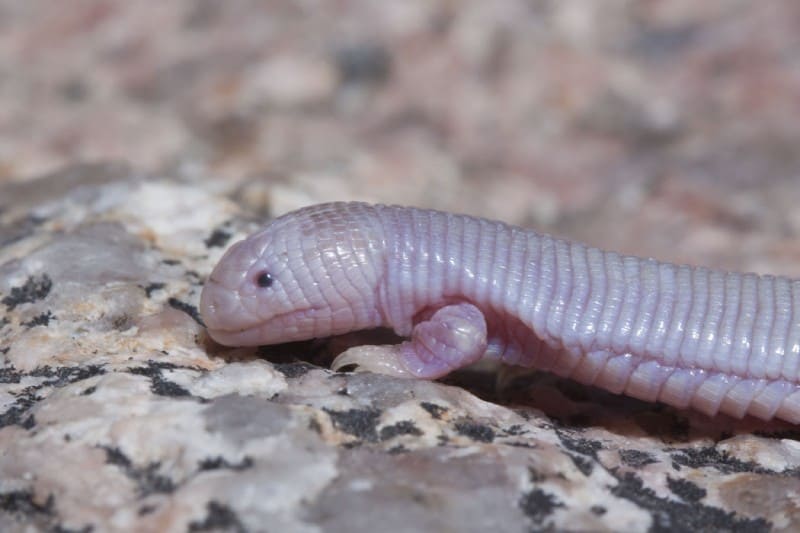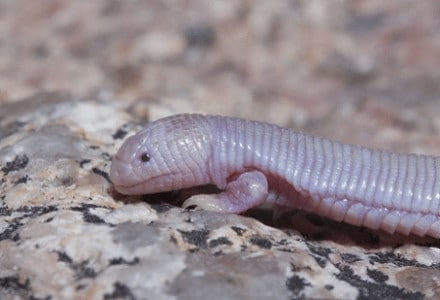
Mexican Mole Lizard Facts
- Most notably, despite its common name, the truly astonishing Mexican Mole Lizard represents neither a mole nor a lizard. However, this extremely unique and rare animal does hide a small secret. That’s due to the fact that it actually constitutes a very odd type of small reptile.
- Furthermore, this incredibly unique creature also represents one of only 180 known species placed in its genus. In addition, each and every one of them have one thing in common. That’s because, in point of fact, none of the members of the genus classify as either lizard or snake.
- Yet the surprising animal sets itself apart from even the great majority of its fellow members of the genus in one specific way. That holds true because it remains one of only four known species in this small genus to display a certain trait. That’s because the others do not possesses any legs at all.
- The Mexican Mole Lizard also qualifies as what scientists call an amphisbaenian. Most unfortunately, being exclusively a subterranean dweller, the remarkable animal is rarely seen. Finally, the average lifespan of this incredibly interesting animal measures only about two years.
Related Articles
Tuatara Leaping Lesbian Lizard Draco Volans
Photographer: marlin harms
CC License: http://bit.ly/2xQPH8p
Mexican Mole Lizard Physical Description
First of all, the breathtaking species known as the Mexican Mole Lizard remains a rather diminutive variety of reptile. That’s because individuals attain a maximum known length of roughly 9.5 in (24 cm). In addition, the width of the small bodies also typically measures only about 0.25 in (6 mm).
Additionally, its coloring represents yet another remarkable physical trait, further setting it apart. That occurs due to the fact that the fascinating creature typically develops predominantly varied shades of pink. This distinctive appearance occurs due to a complete lack of skin pigmentation.
Further, the amazing Mexican Mole Lizard possesses only two, very short legs. However, Nature placed these appendages directly behind the animals’ small head. Five toes with sharp, comparatively long claws also appear on each of the feet. Its skin also grows rather closely segmented, like an earthworm.
In addition to its other traits, the remarkable little lizard also evolved as oviparous in nature. Furthermore, the female of the fascinating species generally lays between 1-4 eggs. Finally, the extremely interesting small reptile exhibits no recognizable degree of the trait of sexual dimorphism.
- Kingdom: Animalia
- Phylum: Chordata
- Class: Reptilia
- Order: Squamata
- Family: Bipedidae
- Genus: Bipes
- Species: B. biporous
Photographer: marlin harms
CC License: http://bit.ly/2xQPH8p
Mexican Mole Lizard Distribution, Habitat, and Ecology
The fabulous Mexican Mole Lizard appears to only be endemic to portions of the Baja Peninsula, Mexico, in southern North America. However, currently unconfirmed sightings also place its range from the extreme southwestern portions, through Big Sur, and into to the Western Cape Region.
In addition, the natural habitat of this remarkable reptile remains predominantly dry to desert regions. But, it also appears to require the presence of plentiful shrub vegetation. Quite unfortunately, to date, this incredible animal has not shown itself to be particularly adaptable to other habitat types.
In all regions it inhabits, members of the species typically prefer to remain below ground. There, the creature lives under the many layers of vegetation. This it does for a specific reason. That’s because this location provides it with at least a measure of protection from potential predators.
Additionally, the resourceful Mexican Mole Lizard constructs lengthy and elaborate systems of tunnels beneath the ground. It also evolved as carnivorous in nature and will prey on virtually anything small and soft enough to swallow. Unless disturbed, it usually remains close to its burrows.
Species Sharing Its Range
Century Plant Cuckoo Bee Volcano Rabbit
Check out our other articles on 7 Magnificent Wild Canines, Black Rain Frog, Jeju Island, Gray Mouse Lemur, Amazon Lily, Golden Pheasant, New Zealand Giraffe Weevil

